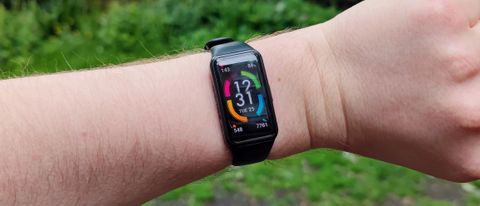TechRadar Verdict
Unless you own a Huawei or Apple smartphone you can’t use connected GPS with the Honor Band 6, which renders it useless for workout tracking. It also has flaws with a few other key health and lifestyle features, and lags behind in areas where rivals excel, and its low price and lightweight design aren’t sufficient compensation.
Pros
- +
Low price
- +
Lightweight design
- +
Good battery life
Cons
- -
Connected GPS only works on certain phones
- -
Inaccurate sleep tracking
- -
Has to be imported
Why you can trust TechRadar
Two-minute review
Of the many smartphone companies that also make wearables, Honor is arguably one of the best – its smartwatches are feature-flush and affordable, and its fitness trackers are great low-cost health and workout devices.
The affordable fitness tracker market is a busy one, with the Honor Band range rivalling the Huawei Band and Xiaomi Mi Smart Band ranges, the Oppo Band, the OnePlus Band, the Samsung Galaxy Fit and more.
Honor used to reign supreme, with its Band 5 being one of our favorites, and this introduction may seem to contradict the negative verdict and low score for the Honor Band 6 you see above. This is the first of the company’s wearables we’ve been disappointed with in a long time – it has a few major issues, and misses out on some key features, and as a result it’s hard to recommend.
Our first, and biggest, problem with the Honor Band 6 is with its GPS. While some wearables have built-in GPS, so that they can track location and distance, most (especially at this price point) have connected GPS, so they use your smartphone’s location to gather their data.
The Honor Band 6 only lets you do this if you have a Huawei or Honor phone running the brand’s EMUI Android overlay, or an iPhone – otherwise you’re not able to use connected GPS at all. If you own a different device, the Honor Band 6 won’t record your workout map, and will return pretty inaccurate distance data too (as it’s based on other factors like steps).
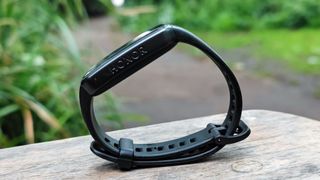
The lack of this very basic feature makes the Honor Band 6 hard to recommend on its own (unless you have one of these phones, of course), but there’s more. We found sleep tracking was fairly inaccurate, while some key workout modes, like outdoor cycling, aren’t available on the watch unless you’re in the cool GPS crew.
So ignoring the ‘fitness’ part of ‘fitness tracker’, what’s the Honor Band 6 like as a standard wrist companion? Well, it’s not as bad – notification handling, weather reports and timers and alarms all work fine, the battery lasts a fairly long time, and the band’s pretty small.
Does the band’s low cost redeem it? That’s hard to ascertain – while it’s definitely a budget band, it launched for a higher price than the Honor Band 5, although its price dropped well below that of its predecessor almost immediately.
We’ll go into more detail about our issues with the Honor Band 6 below, but if you’re just reading this review for our buying advice, it would be “Don’t”. Instead check out the Honor Band 5, or one of the other devices on our list of the best cheap fitness trackers.
Honor Band 6 price and availability

The Honor Band 6 launched for $50 (roughly £35, AU$65), and is available from online retailer AliExpress – it’s not on sale from Honor’s website or better-known online retailers like Amazon.
AliExpress is an import website, so if you order the device it’ll take a while to get to you, likely around a month. There are plenty of listings for it, with different companies importing it from different countries, but the official Honor listing is this one.
The Honor Band 6 was available from AliExpress for less than its list price almost immediately upon its release – we saw it listed for £26 in the UK for example – so if you really want to buy this fitness tracker you should be able to get it for a low price if you shop around.
Design
The Honor Band 6 brings some design improvements over the Band 5 – in particular, it seems that some of the DNA of the Honor Watch ES (a pricier Honor smartwatch) is here. It’s your standard body-and-two-straps design, although the straps are a little harder to remove than on most bands.
The strap is made of silicone, which isn’t the most comfortable band material in the world, but it’s standard for this kind of tracker, and it can be replaced with a third-party strap if you prefer. It has plenty of holes for an easy fit and is really long too, so you don’t need to worry about your wrist being too big.
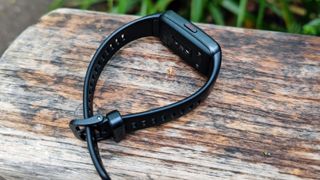
The body is noticeably larger than that of the Band 5 and rival fitness trackers, mainly thanks to the large display. It has a single button, which brings up the app menu, and some sensors on the back.
The Honor Band 6 is water-resistant up to 50 meters, and though there’s no official IP rating, that water resistance pretty much guarantees that it’s splash-proof, and safe for swimming.
While the Honor Band 5 had a 0.95-inch display, on the Band 6 it’s bumped up to 1.47 inches, a sizeable increase that makes menus, options and figures easier to see. It’s a touchscreen that takes up the entirety of the front of the body – there’s no front button here, as on the Band 5 – and has a 194 x 368 resolution.
There are plenty of watch faces to choose from; you’re not limited to a select few, as has been the case with previous Honor fitness trackers, as you can download more via the app. You can even use your own photos as the face, an opportunity we never pass up.
Everyday use
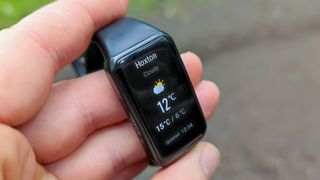
The Honor Band 6 ticks all the boxes for everyday use. Notification handling works well, weather reports are fairly accurate, and ambient activity tracking was largely accurate.
There’s constant heart rate tracking and stress monitoring, as well as step and active-hour counting. You can also set up reminders to alert you if you’re idle for too long
Less impressive is sleep monitoring, which felt inaccurate at times. While the feedback you receive, which includes a sleep score, breakdowns of the types of sleep you have, and a night-by-night comparison, is useful, it’s not always reliable, especially when it comes to start and finish times.
The sleep tracker often conflated ‘lying in bed’ with ‘being asleep’, so that if we lay in bed reading before sleep, or dozed in bed before getting up, our overall sleep time could be artificially inflated. For some reason, we could even use the band and it wouldn’t detect that we were awake.
Another issue we found with the band in everyday use was with music control, as the band often told us we were listening to a song that was actually a few tracks back in the playlist. The controls, such as skipping songs and pausing, worked fine though.

A few other features were useful though like alarms, stopwatches, timers and a Find My Phone function that set off an alarm so loud that people a block over could hear where our smartphone was.
Honor claims the Band 6 has a 14-day battery life, but we can’t quite concur – 11-12 days feels a better estimate of how long you can go between charges, which is pretty much fine for a fitness tracker, and means you won’t have to be constantly checking your battery level. Charging takes about an hour, and is done via a dock that comes with the band, which plugs into any USB port.
Fitness tracking
Our biggest issue with the Honor Band 6 is that it just wasn’t great for tracking our runs, the reason being that its connected GPS won’t work for many people.
For the uninitiated, ‘connected’ GPS is where a fitness tracker or watch gains its location data from a smartphone it’s paired to via Bluetooth. Low-cost bands tend to use this, instead of having their own GPS.
On the Honor Band 6, for some reason, you can only use connected GPS if you have a Huawei phone or an iPhone. The Huawei Health app (Honor used to be a sub-brand of Huawei, and this band is their last collaboration) states that: ‘If you want to record your workout route, make sure [...] your phone is running EMUI 5.0 or later, or iOS 9.0 or later’.
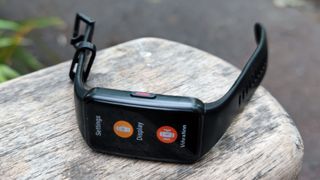
So if your phone runs stock Android, as the phone we used while testing the band does, or if you have a device from Samsung, Xiaomi, OnePlus, Oppo or any other Android phone brand, you’re out of luck. We couldn’t see any mention in the marketing materials of the fact that this key fitness feature doesn’t work on the vast majority of phones, and we’re sorry that you had to learn such an important detail via this review.
Technically, there’s a way to get location data for your workouts. The Huawei Health app lets you track your workouts, and when you press the ‘go’ button on the app, your fitness tracker also starts a countdown. But not only does having to use your smartphone defeat the object of having a fitness tracker, there are discrepancies between the time and location reported by the band and by the phone – and furthermore, the Workout Record function of the band doesn’t log these workouts.
So, unless you’ve got a phone from Huawei or Apple, we wouldn’t recommend picking up this fitness tracker.
The Honor Band 6 features 10 exercise modes: Outdoor run, Indoor run, Outdoor walk, Indoor walk, Indoor cycle, Pool swim, Elliptical, Rower and ‘Other’. There’s also an Outdoor cycle mode, but as with GPS tracking, this is exclusive to Huawei or Apple users.
If you’re not using this connected GPS, distance tracking on runs was pretty inaccurate (as it’s based on some other factors, like steps) and we frequently found that the watch reported distances that were way off. When we went on our standard 8km run for example, the watch thought we’d completed less than 7km.

Tracking that doesn’t use GPS isn’t so bad though. There’s steps, cadence, stride, heart rate and pace, which should be useful for many users.
There are a few more modes on the watch too. There’s Sp02 monitoring, which takes about 10 seconds to give you a reading, and female cycle tracking, which charts your menstrual timings and informs you of your fertile window, although activating this requires jumping through some hoops on the app.
Companion app
We’ve already described the necessity of using the app for some users, but generally, Huawei Health is one of the better wearable tie-in apps we’ve tested – it just doesn’t get a chance to shine here.
You can see routes you’ve taken on workouts, with a kilometer-by-kilometer breakdown of your exercise (although, unless you use the workaround we detailed above, you won’t get workout maps). You can also see a more detailed breakdown of all the metrics tracked.
It’s easy to access other kinds of data tracked too, like your sleep habits or stress levels.
Huawei Health can also be used to change your watch face – there are plenty of options that you can install from an online gallery, though we always like to use our own photos, which you can do here. You can even select multiple photos, turning your watch face into an on-the-wrist slideshow.
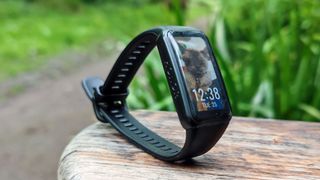
If we have one complaint about Huawei Health, it’s that it can sometimes be buggy. We’ve never managed to log in using SMS, on this or any other device, as the servers always seem to be down, and we had trouble pairing with the Band 6 with our phone, as the app’s device list didn’t populate for the first few days of our testing period.
A Huawei Health update mid-way through our testing period caused us to reconsider our previously-positive thoughts on the app. Now, when tracking workouts via your phone, if the phone isn’t in use (so is locked), an always-on data display fills the screen. The display also provides workout controls, with an option to pause the timer or mute the distance announcer, and it also shows where you are on a map.
However this display has multiple negative effects on a workout. The ‘pause run’ button is really easy to accidentally hit with your hand; the display is constantly on, which drains your phone’s battery quickly; and there’s no obvious way to minimize it, even if you unlock your phone. In fact, the only way we could access Spotify to change music on a run was to open that app via the swipe-down menu on our phone.
We could find an option in the settings to stop this map appearing, and the aforementioned issues had a negative effect on our workouts.
Should I buy the Honor Band 6?

Buy it if...
You don’t like small screens
Many fitness trackers have tiny screens, and the display on the Honor Band 6 is relatively large in comparison, so it’s a bit easier to see.
You like using your own photos as your watch face
It’s great fun using your own pictures as a watch face, and unlike on many wearables it’s an option here.
You have a Huawei phone or iPhone
You’ll only be able to make the most of the Honor Band 6 if you have a phone from Huawei or Apple, and if you do, you can overlook much of the negativity of this review – but not all of it.
Don't buy it if...
You don’t have a Huawei phone or an iPhone
Do you own a phone from Samsung, Xiaomi, OnePlus, Oppo, Motorola, Realme or even Honor? Without GPS the Honor Band 6 isn’t very good at fitness, so forget about buying it.
You want to track sleep
We often found sleep tracking inaccurate, and other trackers and smartwatches do it better. If you want to know how well you slept, this isn’t a good choice.
You’re uncomfortable with importing
Many people don’t like to import their gadgets from other countries, not least because it’ll take ages to arrive, but that’s the only way of getting the Honor Band 6.
First reviewed May 2021

Tom Bedford was deputy phones editor on TechRadar until late 2022, having worked his way up from staff writer. Though he specialized in phones and tablets, he also took on other tech like electric scooters, smartwatches, fitness, mobile gaming and more. He is based in London, UK and now works for the entertainment site What To Watch.
He graduated in American Literature and Creative Writing from the University of East Anglia. Prior to working on TechRadar, he freelanced in tech, gaming and entertainment, and also spent many years working as a mixologist. He also currently works in film as a screenwriter, director and producer.

Over a billion users could be at risk from keyboard logging app security flaw

Apple is reportedly developing its own AI servers — could it be gearing up to take on Nvidia and AMD?

This Game Boy-styled MagSafe stand just tickled my retro-gaming synapse – now all I need is a matching controller for Nintendo emulators
